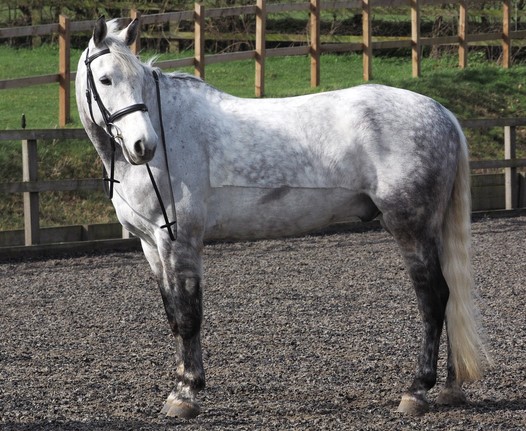Clip Clop...Clipping for a Successful Winter Season

by Aubrey Moore
The leaves are turning orange, the smell of pumpkin spice is in the air. It's almost time for Halloween show costume contests and Thanksgiving horse boarding barn parties. Along with the cooler weather comes wooly mammoth coats, and that's why in today's post, we're talking about clipping plans before the days get too short.
Why People Clip
Most of us don't slow down with our training and riding through the winter season, but it's more important than ever that you spend time on horse care. A thick coat of hair can trap sweat under the saddle and girth regions, taking forever to dry. A wet coat is a cold coat, and it can cause a horse to stay chilled long past the time your ride is done. A properly clipped coat can strike a balance between helping a horse cool down and giving them some natural protection from the elements.
Even better, a clipped coat stays cleaner, meaning you spend less time trying to get winter mud out of long hairs and more time in the saddle. And trimmed legs mean less dirt trapped next to skin, cutting down on the risk of common bacterial and fungal infections such as scratches.
How to Clip
-
Prep Your Tools
At a minimum, you'll need a set of clippers and lubricating oil. It can also be handy to have a step stool, extension cord, and a toothbrush (to clean out the teeth of the clippers as needed), as well as a hay bag or treats to keep your horse distracted during the process. If you plan on a full body clip, you may even want to invest in a grooming halter. Finally, consider having a pair of scissors handy to clean up fetlocks or other areas before using clippers.
-
Start with a Clean Horse
Blades will glide easier through clean hair, and you don't want your process slowed down by muddy clipper blades. Practicing good horse care and thoroughly brushing your horse to remove dirt and loose hair prior to clipping is a must. If you can go one step further by bathing the horse and using a product like Show Sheen to make hair super slick, you'll find your clippers will work with much less effort (and require fewer breaks to clean them out or cool them down).
-
Choose a Well-lit, Quiet Spot
Clipping can be stressful enough, and although we've all clipped under barn lights late the night before a show, if you can clip in natural light, you'll find the whole process a bit easier. Also, clip when the barn is quiet and at a place far away from any regular hustle and bustle to give your horse the best opportunity to relax.
-
Use Good Technique
With few exceptions, plan on clipping against the direction of hair growth while using long strokes to limit clipper marks. Use your off-hand to pull skin taut, and don't be afraid to go slow. You'll also want to take frequent breaks to prevent clippers from becoming too hot and burning the horse (and to let your arms rest!).
-
Don't Worry if it Takes More than One Session
If your horse isn't frequently clipped, you may find his patience with clipping quickly wearing thin. Therefore, it's better to break your clipping session into small, 15-20 minute sessions over several days, rather than pushing one bad situation for several hours. Otherwise, you might find the next clipping session an even worse experience.
Tips on Making Clipping Easier
-
A Relaxed Horse is a Happy Horse
You know your horse best, so consider the best time and place to clip them. Do they feel more relaxed around their barn buddy? With a bag of hay to munch on? Try to set both of you up for success before you ever trim the first hair.
-
Clip Early, Clip Often
Shorter hair is easier to maintain than trying to clip a full winter coat. Expect to perform your first clip in the September/October timeframe and perform touch-ups throughout winter as needed. More frequent clipping sessions will also help keep your horse use to the sound and sensation, resulting in more relaxed clips overall.
-
Maintain Your Clippers
Old, dull blades will pull at hair, frustrating your horse and resulting in uneven lines and clipper marks. Take care of your blades by cleaning and lubricating them after the last clip of the year (and getting blades sharpened in the off-season), as this will help make sessions go more smoothly.
Wondering what else you should do to prepare for winter? Check out our article on prepping you and your horse for the winter season here.
-
Prevent Track Lines
Track lines are marks left behind by clippers. These can be from uneven pressure, inconsistent clipper cutting (typically due to dirty hair), or even the horse's movement as you work. You can also get clipper marks if you switch clipper sizes in the same location (such as using big clippers then small along the horse's barrel). If you've left behind some marks, don't be afraid to go back over the same area to eliminate them. But know that the best way to prevent them in the first place is through preparation and good technique!).
With a bit of preparation and some patience, you can have a clean, clipped horse that's ready for whatever mud or sweat the winter season brings.
About Aubrey Moore:
Over the years, Aubrey has dabbled in a variety of equestrian activities such as eventing, dressage, Pony Club, and one epic safari ride across Africa. When she isn’t busy freelance writing for such publications as Horse Network, she can be found at home with her pony Khali and pony-sized cat, Frankie.






